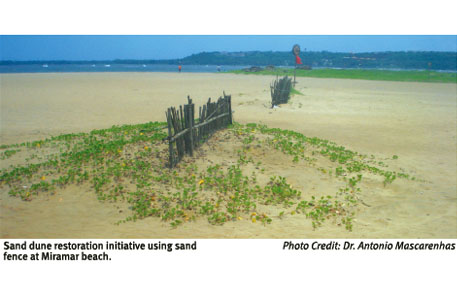Solutions to tackle climate change
INTRODUCTION
There is no single solution that fits all when it comes to tackling the impacts of climate change (CC). It has to be a combination of both mitigation and adaptation measures and is a continuous process. Mitigation looks at limiting CC by reducing the global emissions of greenhouse gases, while adaptation aims to lessen the adverse impacts through a wide-range of actions at the local level. Mitigation actions have been discussed earlier and the adjacent schematic summarises them. The focus of this article is on things to do locally to build adaptive capacity.

Adaptation Measures
Actions that are taken to adjust to CC, moderate potential damages or cope with its consequences, constitute 'Adaptation Measures'. It is therefore a blend of policy and technology, and how fast they can be implemented. Adaptive capacity can be both, at the country and the local level.
The Prime Minister's Council on Climate Change has drawn a national action plan on climate change. It has eight national missions to address various CC related issues across the country. The Government of India has also established a National Adaptation Fund on Climate Change (NAFCC) to assist State and Union Territories that are vulnerable to the adverse effects of CC in meeting the cost of adaptation.
- Climate Change in India: 4X4 Assessment" by MoEF & CC, brings together 4 major regions in India, namely Himalayan region, the north-Eastern region, the Western Ghats and the Coastal region with respect to observed climate and climate change projections in the year 2030 on 4 key sectors of agriculture, water, natural ecosystem & biodiversity and human health.
- Out of these 4 regions, Goa falls in two regions i.e. the coastal and the Western Ghats regions. Hence, this warrants timely adaptation action at the State level.
| Adaptation goals for coastal climate change | |
| ADAPTATION MEASURE | RELEVANCE TO CC |
| FUNCTIONAL AND HEALTHY COASTAL ECOSYSTEM | |
| Coastal wetland protection and restoration | Acts as buffer against extreme weather events, storm surge, erosion, floods; limits salt water intrusion. |
| Marine conservation & protected area | Improves the resilience of coastal ecosystems to CC, fisheries productivity and improves the economic and social conditions of coastal communities. |
| Financial support for ecosystem services | Availability of funds to protect critical habitats that defend damages from flooding/erosion/storms. |
| INCREASING ROBUSTNESS OF INFRASTRUCTURE (BUILT ENVIRONMENT IS LESS EXPOSED) | |
| Building standards | By incorporating climate considerations in building design, it reduces damage and human safety risks from CC impacts. |
| Beach and dune nourishment | Protect shores and restores beaches; serves as a 'soft' buffer against flooding, erosion, storm surges etc. |
| Coastal development setbacks and implementation of Coastal Regulations Zone (CRZ) rules | Reduces the infrastructure losses and human safety risks |
| Structural shoreline stabilization | Temporary buffer against erosion |
| DIVERSIFIED LIVELIHOODS | |
| Fisheries sector good practices | Contributes to the protection of rural livelihoods, food security and marine biodiversity against extreme events. Training on alternate livelihood options through aquaculture to be given. |
| HUMAN SAFETY AND HEALTH | |
| Community based disaster risk reduction, health programs | Early warning systems, capacity building of local communities to respond to the effects of CC. |
| OVERARCHING PLANNING AND GOVERNANCE | |
| Integrated water resources management in the coastal context | Preserves estuaries, which act as storm buffers and protect against coastal groundwater salinization. |
| Mainstreaming adaptation through policy instruments | Identifying entry points in national and regional policies to seek funds to execute adaptation plan. |
Goa being a tourist destination faces pressure from tourism, and also needs to manage threats of climate change on tourism. Some of the key adaptation measures that Goa needs to undertake to cope with CC impacts are listed in the table below.
TERI completed a study in 2016 to enable policy for undertaking adaptation measures at the state level. State level policy reviews and multi-department engagements were carried out in Goa and Uttarakhand to plan a detailed roadmap factoring urban climate resilience in cities of the two states. Identification of entry points in national and regional policies was also done.


Goa is one of the low vulnerability states to tropical cyclones and consequent recurrent loss of life and property. The Government of India has a National Cyclone Risk Mitigation Protection (NCRMP) plan which is being implemented in Goa. It would entail building of cyclone protection shelters and rehabilitation of 30 km of bunds to prevent salinity ingress.
While there are some sporadic initiatives taken to tackle the impacts of CC, there is a lot of scope to improve and take it further. Creating more awareness, political will and a concerted effort is required to plan a secured future for Goa.
